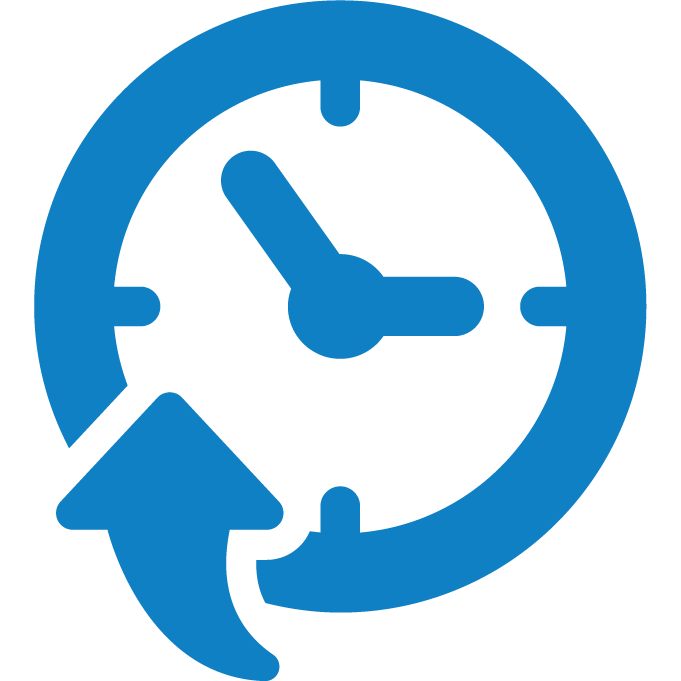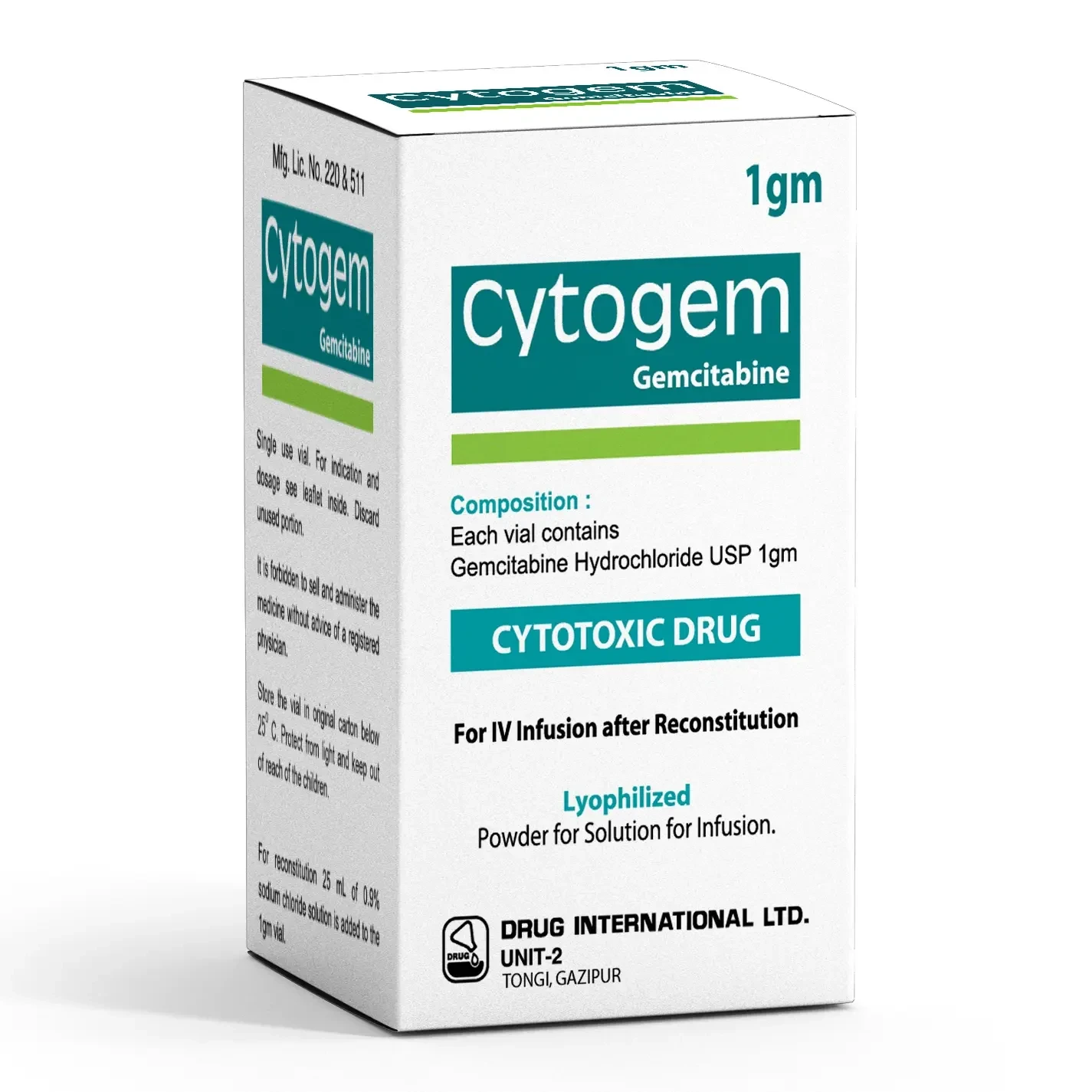
✔ 100% Authentic Product
👁️ Currently Viewing 1142
Cytogem Gemcitabine 1gm IV Infusion
Gemcitabine (dFdC) is metabolized inside cells to its active forms, diphosphate (dFdCDP) and triphosphate (dFdCTP) nucleosides. Its mechanism involves:
- Inhibiting DNA synthesis: dFdCDP blocks ribonucleotide reductase, reducing deoxynucleosides (particularly dCTP) needed for DNA synthesis.
- Self-potentiation: dFdCTP competes with dCTP and integrates into DNA, inhibiting further synthesis and triggering apoptosis.
Small amounts may also integrate into RNA. Gemcitabine’s incorporation into DNA causes the termination of chain growth after one additional nucleotide.
Discount
Price: ৳ 4,465
MRP:
৳
4750
6%
Off

100% Genuine Products, Guaranteed

Safe & Secure Payments, Always

Fast, Secure & Efficient Delivery

Proper Packaging
 Cash on Delivery - All over Bangladesh
Cash on Delivery - All over Bangladesh Regular Delivery - 12-24 Hours, Dhaka City* Charge Tk.39-59
Regular Delivery - 12-24 Hours, Dhaka City* Charge Tk.39-59 Regular Delivery - 24-48 Hours, Other Cities* Charge Tk.99-110
Regular Delivery - 24-48 Hours, Other Cities* Charge Tk.99-110
 ফ্রি ডেলিভারিঃ - ৯৯৯ টাকা+ অর্ডারে, ঢাকা
শহরে
ফ্রি ডেলিভারিঃ - ৯৯৯ টাকা+ অর্ডারে, ঢাকা
শহরে ফ্রি ডেলিভারিঃ - ২৯৯৯ টাকা+ অর্ডারে, ঢাকার
বাহিরে
ফ্রি ডেলিভারিঃ - ২৯৯৯ টাকা+ অর্ডারে, ঢাকার
বাহিরে
100% Genuine Products, Guaranteed
Safe & Secure Payments, Always
Fast, Secure & Efficient Delivery
Proper Packaging
 Cash on Delivery - All over Bangladesh
Cash on Delivery - All over Bangladesh Regular Delivery - 12-24 Hours, Dhaka City* Charge Tk.39-59
Regular Delivery - 12-24 Hours, Dhaka City* Charge Tk.39-59 Regular Delivery - 24-48 Hours, Other Cities* Charge Tk.99-110
Regular Delivery - 24-48 Hours, Other Cities* Charge Tk.99-110 ফ্রি ডেলিভারিঃ - ৯৯৯ টাকা+ অর্ডারে, ঢাকা
শহরে
ফ্রি ডেলিভারিঃ - ৯৯৯ টাকা+ অর্ডারে, ঢাকা
শহরে ফ্রি ডেলিভারিঃ - ২৯৯৯ টাকা+ অর্ডারে, ঢাকার
বাহিরে
ফ্রি ডেলিভারিঃ - ২৯৯৯ টাকা+ অর্ডারে, ঢাকার
বাহিরে
✅ Description:
Gemcitabine
Non-Small Cell Lung Cancer (NSCLC):
- First-line therapy: Cytogem, combined with Cisplatin, is used for patients with locally advanced (inoperable Stage IIIA or IIIB) or metastatic (Stage IV) NSCLC.
- Palliative treatment: Suitable for adult patients with locally advanced or metastatic NSCLC.
Pancreatic Cancer:
- Treats adult patients with locally advanced or metastatic adenocarcinoma of the pancreas.
- Indicated for patients with pancreatic cancer refractory to 5-FU therapy.

Bladder Cancer:
- Treats advanced bladder cancer (muscle-invasive Stage IV tumors with or without metastases) in combination with Cisplatin.
Breast Cancer:
- Used with Paclitaxel to treat metastatic breast cancer in patients who relapsed after adjuvant or neoadjuvant chemotherapy. Previous treatment should include anthracyclines unless contraindicated.
Ovarian Cancer:
- In combination with Carboplatin, treats recurrent epithelial ovarian carcinoma in patients relapsing after platinum-based therapy.
(Use only as advised by a registered physician.)
✔️ Uses of Cytogem IV Infusion
- Non-small cell lung cancer
- Breast cancer
- Pancreatic cancer
- Urinary bladder cancer
- Ovarian cancer
✔️ How does Cytogem IV Infusion work?
Cytogem IV Infusion works by interfering with DNA synthesis. It blocks the production of new DNA, by locking itself into the DNA strands and inhibiting any further proliferation or growth of the cell. Hence, Cytogem IV Infusion has widespread application in the field of oncology (cancer-related medicine) and chemotherapy.
✔️ Side Effects: Cytogem IV Infusion
- Hematological: Anemia, leukopenia, and thrombocytopenia are common. Severe cases may require transfusions or dose adjustments.
- Hepatic: Liver enzyme abnormalities (e.g., ALT, AST), which are mild and rarely progressive.
- Gastrointestinal: Nausea, vomiting, diarrhea, and stomatitis.
- Renal: Mild proteinuria and hematuria. Rare cases of renal failure and hemolytic uremic syndrome were reported.
- Pulmonary: Dyspnea, bronchospasm, and interstitial pneumonitis.
- Allergic Reactions: Rash, pruritus, and injection site reactions.
- Neurotoxicity: Somnolence, asthenia, and paresthesias.
- Other: Edema, alopecia, and flu-like symptoms.
✔️ Quick Suggestions:
- Eat more lean meats, healthy fats, fruits, vegetables, and whole-grain foods to give you more energy.
- Avoid taking Gemcite 1gm Injection with alcohol as there may be an interaction.
- Stay hydrated by drinking plenty of water, as dehydration is often seen in cancers.
- Use a reliable contraceptive method to prevent pregnancy while you are taking this medicine.
✔️ Indications: Cytogem IV Infusion
Cancer is the uninhibited and uncontrolled growth of cells in the body, leading to the formation of tumors or abnormal cell clusters that can invade and damage surrounding tissues or spread to other parts of the body (metastasis).
Cytogem is a cytotoxic anti-cancer medication that is used alone or in combination with other anti-cancer drugs to treat various types of cancers, including:
- Breast cancer
- Pancreatic cancer
- Non-small cell lung cancer
- Bladder cancer
- Ovarian cancer
✔️ Overdose of Cytogem
No antidote is available. Overdoses may lead to myelosuppression, paresthesias, or severe rash. Patients should receive supportive care and regular blood count monitoring.
✔️ Non-Small Cell Lung Cancer (NSCLC): Cytogem IV Infusion
- Single-agent: 1000 mg/m² via 30-minute IV infusion weekly for 3 weeks, followed by a 1-week rest. Repeat 4-week cycles.
- Combination therapy:
- 3-week schedule: 1250 mg/m² on Days 1 and 8 of each 21-day cycle.
- 4-week schedule: 1000 mg/m² on Days 1, 8, and 15 of each 28-day cycle.
✔️ Pancreatic Cancer: Cytogem IV Infusion
- 1000 mg/m² via 30-minute IV infusion weekly for up to 7 weeks, followed by 1 week of rest. Subsequent cycles involve injections once weekly for 3 weeks out of every 4-week cycle.
✔️ Ovarian Cancer: Cytogem IV Infusion
- 1000 mg/m² on Days 1 and 8 of a 21-day cycle via 30-minute IV infusion, combined with Carboplatin (AUC 4.0 mg/mL/min) on Day 1.
✔️ Breast Cancer: Cytogem IV Infusion
- Combine with Paclitaxel (175 mg/m² IV infusion on Day 1 for 3 hours), followed by Gemcitabine (1250 mg/m² IV infusion on Days 1 and 8 of a 21-day cycle).
✔️ Bladder Cancer: Cytogem IV Infusion
- Single-agent: 1250 mg/m² on Days 1, 8, and 15 of each 28-day cycle via 30-minute IV infusion.
- Combination therapy with Cisplatin: 1000 mg/m² on Days 1, 8, and 15 of each 28-day cycle, combined with Cisplatin (70 mg/m² on Day 1 or 2).
✔️ Elderly: Cytogem IV Infusion
- No specific dose adjustments are needed, though pharmacokinetics may vary.
✔️ Children: Cytogem IV Infusion
Insufficient safety and efficacy data.
✔️ Renal or Hepatic Impairment: Cytogem IV Infusion
Use cautiously as data on these populations are limited.
✔️ Interactions
No confirmed drug interactions are reported, and no specific studies have been conducted.
✔️ Contraindications
Not to be used in patients with known hypersensitivity to Gemcitabine or any of its components.
✔️ Pregnancy Category D:
Gemcitabine should not be used during pregnancy unless necessary. It is unknown if Gemcitabine is excreted in breast milk; use it with caution in breastfeeding.
✔️ Use cautiously in patients at risk of:
- Myelosuppression
- Pulmonary toxicity
- Hepatic impairment
- Radiation therapy-related toxicity
- Impaired fertility
Avoid in children due to limited safety data.
✔️ Storage
Store vials at 20°–25°C in the original carton, away from light. Do not refrigerate to prevent crystallization. Keep out of reach of children.
✔️
1. .
3.
4.
5.
6.
7.
8.
9. .
10.
⚠️Disclaimer:
At ePharma, we’re committed to providing accurate and accessible health information. However, all content is intended for informational purposes only and should not replace medical advice from a qualified physician. Please consult your healthcare provider for personalized guidance. We aim to support, not substitute, the doctor-patient relationship.






